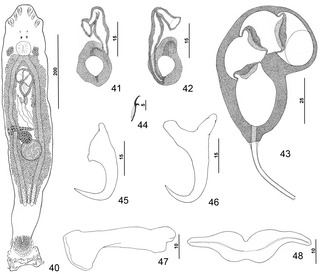
Pseudorhabdosynochus manifestus is a diplectanid monogenean parasite first found in host Epinephelus malabaricus near Nouméa, between its secondary gill lamellae. It can infest its host by the hundreds. It was ascribed that name because it was the most abundant species found while its descriptive study was taking place. As appreciated from studying juvenile specimens, the development of female organs precedes that of male organs in this species and is likely the case in other Pseudorhabdosynochus species.

Pseudorhabdosynochus yucatanensis is a diplectanid monogenean parasitic on the gills of the red grouper, Epinephelus morio. It was described by Vidal-Martínez, Aguirre-Macedo & Mendoza-Franco in 1997 and redescribed by Kritsky, Bakenhaster and Adams in 2015.

Pseudorhabdosynochus justinella is a diplectanid monogenean parasitic on the gills of the red grouper, Epinephelus morio. It has been described by Kritsky, Bakenhaster and Adams in 2015.

Pseudorhabdosynochus kritskyi is a diplectanid monogenean parasitic on the gills of the gag, Mycteroperca microlepis. The species has been described by Dyer, Williams and Bunkley-Williams in 1995 and redescribed successively by Yang, Gibson and Zeng in 2005 and by Kritsky, Bakenhaster and Adams in 2015. The name of the species honours the American parasitologist Delane C. Kritsky.

Pseudorhabdosynochus capurroi is a diplectanid monogenean parasitic on the gills of the Black grouper, Mycteroperca bonaci. It was described by Vidal-Martínez and Mendoza-Franco in 1998 and redescribed successively by Yang, Gibson and Zeng in 2005 and by Kritsky, Bakenhaster and Adams in 2015.

Pseudorhabdosynochus hyphessometochus is a diplectanid monogenean parasitic on the gills of the yellowmouth grouper, Mycteroperca interstitialis. It has been described by Kritsky, Bakenhaster and Adams in 2015.

Pseudorhabdosynochus sulamericanus is a diplectanid monogenean parasitic on the gills of the snowy grouper, Epinephelus niveatus, the Warsaw grouper, Epinephelus nigritus and the Haifa grouper, Epinephelus haifensis. It has been described by Santos, Buchmann & Gibson in 2000 , redescribed by Kritsky, Bakenhaster and Adams in 2015. and again redescribed by Chaabane, Justine, Gey, Bakenhaster & Neifar in 2016.

Pseudorhabdosynochus firmicoleatus is a diplectanid monogenean parasite on the gills of the Yellowedge grouper, Epinephelus flavolimbatus and the Snowy grouper, Epinephelus niveatus. It was described by Kritsky, Bakenhaster and Adams in 2015.

Pseudorhabdosynochus mcmichaeli is a diplectanid monogenean parasitic on the gills of the scamp, Mycteroperca phenax. It has been described by Kritsky, Bakenhaster and Adams in 2015.

Pseudorhabdosynochus meganmarieae is a diplectanid monogenean parasitic on the gills of the Graysby, Cephalopholis cruentata. It has been described by Kritsky, Bakenhaster and Adams in 2015.

Pseudorhabdosynochus vascellum is a diplectanid monogenean parasitic on the gills of the scamp, Mycteroperca phenax. It has been described by Kritsky, Bakenhaster and Adams in 2015.

Pseudorhabdosynochus contubernalis is a diplectanid monogenean parasitic on the gills of the Scamp, Mycteroperca phenax. It has been described by Kritsky, Bakenhaster and Adams in 2015.

Pseudorhabdosynochus monaensis is a diplectanid monogenean parasitic on the gills of the rock hind, Epinephelus adscensionis. It has been described by Dyer, Williams & Bunkley-Williams in 1994 and redescribed by Kritsky, Bakenhaster and Adams in 2015.

Pseudorhabdosynochus mycteropercae is a diplectanid monogenean parasitic on the gills of the tiger grouper, Mycteroperca tigris (Serranidae). It has been described by Kritsky, Bakenhaster and Adams in 2015.

Pseudorhabdosynochus williamsi is a diplectanid monogenean parasitic on the gills of the rock hind, Epinephelus adscensionis. It has been described by Kritsky, Bakenhaster and Adams in 2015.

Pseudorhabdosynochus mizellei is a diplectanid monogenean parasitic on the gills of the red hind, Epinephelus guttatus. It has been described by Kritsky, Bakenhaster and Adams in 2015. The species was named Diplectanum epinepheli by Mizelle & Wood but this name was not published and is a nomen nudum according to Kritsky, Bakenhaster & Adams (2015).

Pseudorhabdosynochus bunkleywilliamsae is a diplectanid monogenean parasitic on the gills of the Nassau grouper, Epinephelus striatus. It has been described by Kritsky, Bakenhaster and Adams in 2015.

Pseudorhabdosynochus woodi is a diplectanid monogenean parasitic on the gills of the red hind, Epinephelus guttatus. It has been described by Kritsky, Bakenhaster and Adams in 2015.

Pseudorhabdosynochus tumeovagina is a diplectanid monogenean parasitic on the gills of the speckled hind, Epinephelus drummondhayi. It has been described by Kritsky, Bakenhaster and Adams in 2015.
Pseudorhabdosynochus hargisi is species of a diplectanid monogenean parasitic on the gills of the White grouper Epinephelus aeneus. It was described in 1984 as Diplectanum hargisi and transferred to the genus Pseudorhabdosynochus by Santos, Buchmann & Gibson in 2000. Its systematic position has been clarified by Kritsky, Bakenhaster & Adams in 2015, who differentiated it from Pseudorhabdosynochus americanus.




















